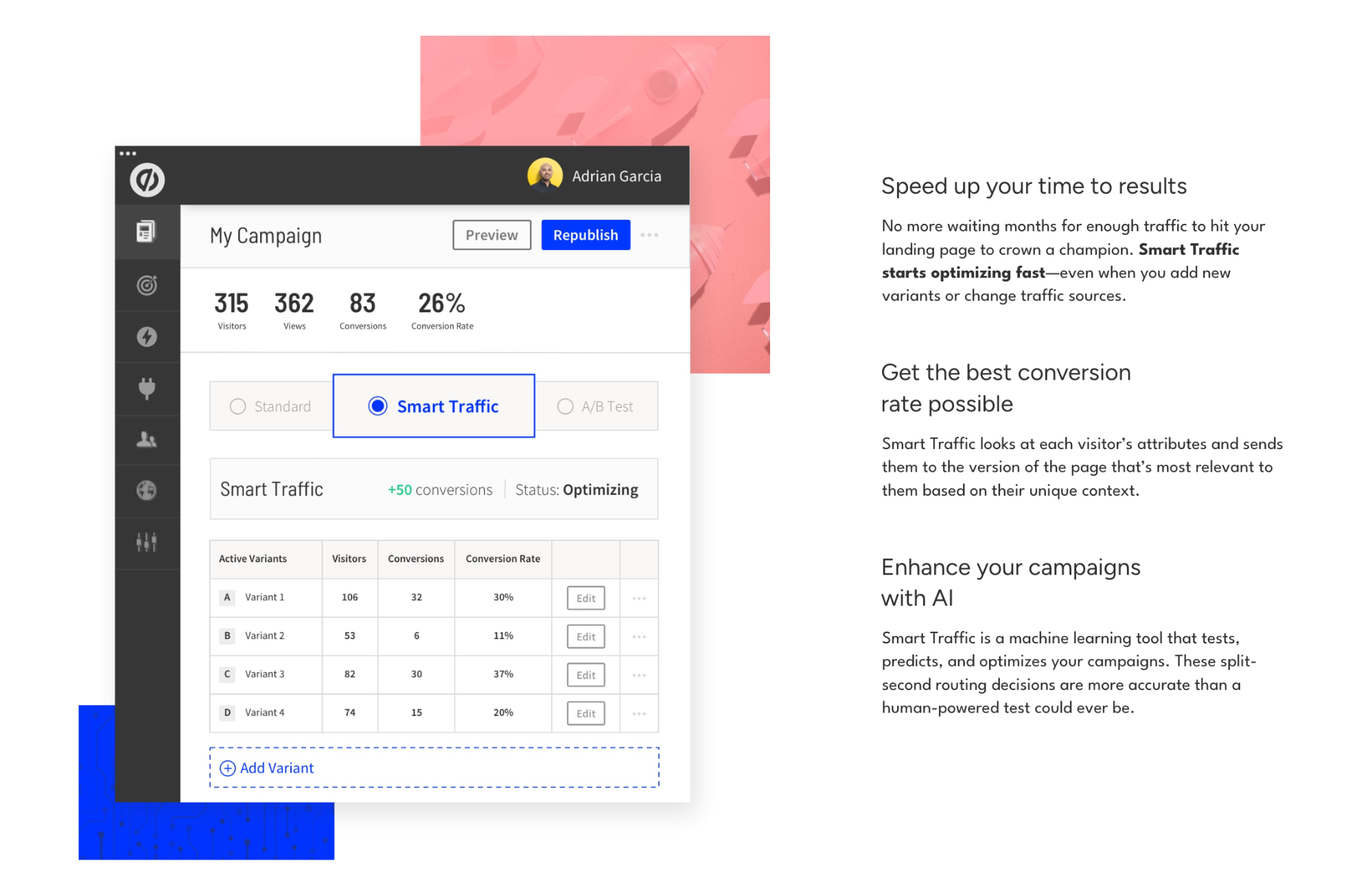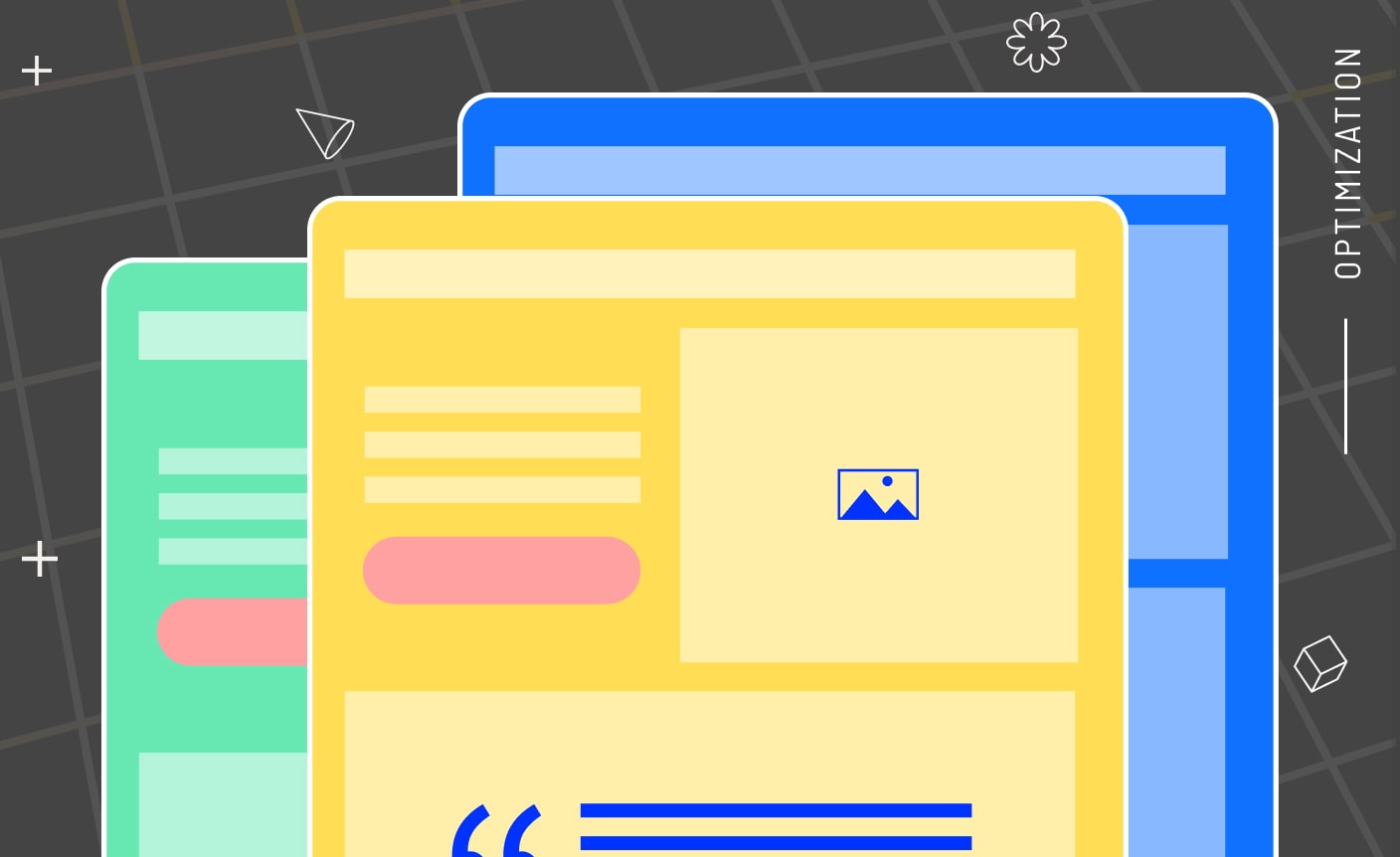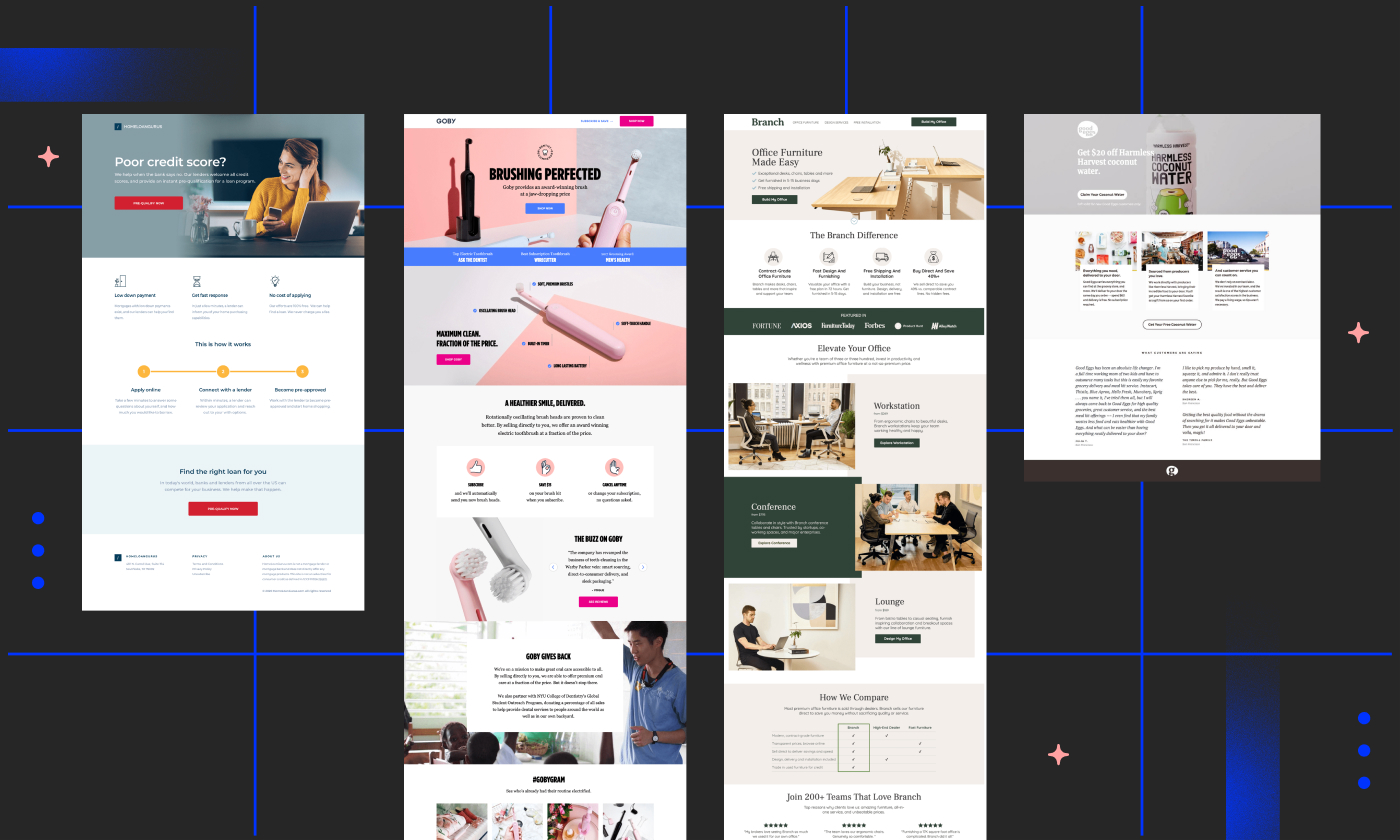
How to generate leads from your website (16 pro tips)
Let’s be honest—your website should be your hardest-working sales rep.
But most websites? They’re more like that employee who shows up late and spends half the day scrolling Instagram. They look nice enough, but they’re not exactly crushing their conversion goals.
TABLE OF CONTENTS
Here’s the thing:
You don’t need a total site overhaul or a million-dollar redesign to start generating more high-quality leads. What you need are smart, strategic tweaks that transform casual browsers into qualified prospects—without waiting weeks for your IT team to implement them.
The shift is happening. Marketing teams are taking control back from developers, creating landing experiences they can test and optimize themselves. And the results speak for themselves.
Small changes. Big impact. Real leads.
In this guide, we’ll walk through 17 battle-tested strategies and lead capture methods to help you convert more visitors into leads. These aren’t just theoretical best practices—they’re practical tactics used by successful marketers to drive measurable ROI on every campaign.
Ready to turn your website from a digital brochure into a lead-generating powerhouse? Let’s dive in.
Why generating leads from website pages still matters
Social media is fun. Email is reliable. Paid ads get results.
But your website? It’s still home base for your lead generation efforts.
Think about it this way:
When someone visits your site, they’re actively looking for what you offer. They’ve done the hard work of finding you. Your only job now is to convert them.
The problem is most websites are built to show, not convert. They’re like museums—pretty to look at but don’t exactly scream “touch me!”
That’s why most visitors leave without a trace, taking their potential business elsewhere.
But here’s where it gets interesting—you don’t need a massive overhaul of your entire website or lead generation process to see results. Small, strategic tweaks can transform your website’s performance overnight. We’ve seen companies double their conversion rate by literally changing three words in their call to action.
When someone clicks a link in your ads, emails, social posts, or content assets in the wild—they land on your site.
Make it count.
The strategies we’re about to share will help you close the gap between traffic and conversions, turning more of your existing visitors into leads your sales team will actually thank you for.
16 proven strategies to generate more leads from your website
The gap between “we need more leads” and “we got more leads” isn’t as wide as you might think.
These strategies aren’t theoretical—they’re the same tactics the most successful Unbounce users are implementing every day to turn casual browsers into paying customers. No coding needed, no IT tickets required.
Let’s turn those visitors into something your sales team can actually work with.
1. Use dedicated landing pages for campaigns
Ever clicked an ad promising the solution to your biggest problem, only to land on a generic homepage and think “Wait, where did that thing go?”
Your homepage has a tough job—it’s trying to speak to everyone who might possibly care about your business. Multiple CTAs, navigation options, company history… it’s a buffet when your visitor just wanted a specific dish.
The fix? Landing pages built for ONE campaign and ONE conversion goal.
Here’s why they crush homepages at lead generation:
- They deliver exactly what your ad promised (no bait and switch)
- They offer one clear next step (no decision paralysis)
- They strip away distractions (no navigation menu rabbit holes)
But let’s be real—most companies hit the same wall:
“We need a developer to build that page.”
*Cue weeks of waiting while your campaign momentum dies*
That’s why more marketers are taking control with drag-and-drop tools (ahem, like Unbounce). No coding, no IT tickets—just fast, targeted pages that match exactly what your ads promise.
Want to see what actually works? These 7 lead generation landing page examples show how simple tweaks can transform your visitor-to-lead conversion rates.
2. A/B test your headlines, CTAs, and lead forms
“I think this headline will work better.”
“Let’s try a green button instead.”
Stop guessing. Start testing.
Small changes to your pages can have shockingly big impacts on your lead counts. Sometimes it’s as simple as swapping a few words in your CTA.
Take Going, a travel deals company that changed just three words in their call to action from “Sign up for free” to “Trial for free.”

The result?
A staggering 104% increase in conversions month-over-month. That tiny tweak literally doubled their results without spending an extra dollar on traffic.
The truth is, you never know which element will unlock those conversion gains until you test it.
Here are five high-impact elements to start testing today:
- Your primary headline: Test benefit-driven vs. feature-focused approaches. “Save 5 Hours Every Week” might crush “Our Task Management Solution”
- CTA button text: Just like Going, you could see massive gains from a simple tweak.
- Form length: Try a short lead form against a longer one with progressive profiling. Sometimes less is more, but not always
- Social proof placement: Test showing testimonials near your form vs. higher on the page
- Hero imagery: Photos of people using your product often outperform abstract visuals, but test it
The beauty of A/B testing is you don’t need to overhaul your entire page. Small, strategic changes can drive massive improvements in your lead gen results.
Want more test ideas? Check out these 10 A/B testing examples and case studies that drove significant conversion lifts for real businesses.
3. Offer lead magnets that actually solve problems
Let’s talk about lead magnets for a sec.
You know the ones we mean. Those sad little PDFs with titles like “10 Tips for Success” that are basically just sales pitches in disguise.
Here’s the thing:
Nobody—and we mean nobody—is excited to hand over their email for that anymore.
People are protective of their inboxes these days. They’ve been burned too many times by “free guides” that delivered zero value. So when they see your popup asking for their email, their finger is already hovering over the “X” button.
Unless… you offer something they genuinely need.
The best lead magnets solve actual problems your visitors are experiencing right now. They scratch an itch. They deliver an immediate win. Think about your target customer for a minute. What keeps them up at night? What are they trying to figure out today that’s driving them nuts?
That’s your lead magnet.
We’ve seen some killer lead magnets that convert like crazy:
- A calculator that shows exactly how much money you’re losing to cart abandonment
- Templates people can copy, paste, and use right away (no figuring it out themselves)
- Benchmarking tools that tell visitors how they stack up against competitors
See the pattern? These aren’t fluffy content pieces. They’re practical tools that deliver value immediately.
The beauty of lead magnets is they pre-qualify your prospects too. Someone downloading your “Practical Report on Enterprise Data Migration” probably has a data migration project in their future. That’s way more valuable than a random email address.
Want inspiration for creative lead magnets that actually work? Check out these 13 lead generation ideas from marketers who’ve mastered the value exchange.
Remember—when your lead magnet genuinely helps someone, they don’t just give you their email. They start the relationship grateful for your expertise. And that makes all the difference when it comes time to sell.
4. Shorten and simplify your lead capture forms
Ever abandoned a checkout because they wanted your life story?
We’ve all been there. You’re ready to download something—then bam! A form asking for everything short of your blood type. So you bounce. Because honestly? Not worth the effort.
Every field you add to your form puts another hurdle in front of potential leads. And with each hurdle, more people drop out of the race.
So what should you actually ask for?
Start with the bare minimum:
- Email address (obviously)
- First name (for personalization)
- One qualifying question (company size, role, or main challenge)
That’s it.
“But our sales team needs more info!”
Sure they do. But you can get that info later. After you’ve already captured the lead.
This is where conditional logic forms come in clutch. They only display certain questions based on how someone answers previous questions. This lets you progressively build a profile without overwhelming the visitor all at once.
Remember: Your form isn’t the finish line. It’s just the first step in a relationship. You’ll have plenty of chances to learn more about your leads as they move through your funnel.
Ask for what you need now. Save the rest for later.
5. Use Smart Traffic to match visitors to best-converting pages
A/B testing is great. But here’s a secret:
Your visitors aren’t all the same. What works for one segment might bomb with another.
That’s why savvy marketers are ditching the one-size-fits-all approach and embracing AI-powered optimization instead.
Here’s how it works:
Rather than picking one “winner” for everyone, AI analyzes your visitors’ characteristics (like location, device, time of day) and automatically sends them to the page variant most likely to convert them.
Think of it like having a doorman at a party who knows exactly which room each guest will enjoy most.
Some visitors might dig your short, punchy page with minimal copy. Others might need more social proof and detailed explanations. Smart Traffic figures this out—then routes accordingly.
The best part? No waiting for statistical significance.
Traditional A/B tests need tons of traffic and weeks of data before declaring a winner. But Unbounce’s Smart Traffic starts optimizing after just 50 visits, adapting in real-time as more people arrive.

It’s perfect for marketing teams who:
- Don’t have massive traffic volumes
- Need results faster than traditional tests allow
- Want to squeeze more leads from existing campaigns
Setup takes about 2 minutes. Create a few page variants, toggle on Smart Traffic, and let AI handle the rest while you focus on other parts of your campaign.
6. Place CTAs where users naturally look
Your call to action button is the moment of truth. All your clever copy, gorgeous design, and persuasive arguments lead to this one element—the button that turns browsers into leads.
But here’s the problem:
Most sites bury their CTAs where visitors never see them.
The solution isn’t rocket science. Put your CTAs where eyeballs actually go:
- Above the fold: Your primary CTA should be visible without scrolling—period.
- After key benefits: Place secondary CTAs immediately after you’ve made a compelling point.
- At natural stopping points: Give readers a clear next step when they pause.
Want to see this in action? Check out these call to action examples that boosted conversions by following these exact principles.
Pro tip:
Don’t just consider placement—consider context. Your CTA should be the logical next step based on where the visitor is in their journey. Someone who just landed on your page needs a different CTA than someone who’s scrolled through your entire case study.
If visitors have to hunt for how to take action, they simply… won’t.
7. Use social proof to build instant trust
Trust issues?
Your website visitors probably have ’em. And who can blame them? The internet’s full of sketchy offers and broken promises. So how do you convince strangers to hand over their contact info?
It’s like having your most satisfied customers standing next to you, nodding and saying “Yeah, these folks actually deliver.”
Here’s where most people go wrong:
They hide testimonials in a sad little carousel at the bottom of the page. Or they use generic quotes from “Jane S.” at “Company XYZ.”
Weak sauce.
Real, strategic social proof…
- Names real companies your prospects recognize
- Places testimonials next to your form (not buried at the bottom)
- Shows specific results (“increased leads by 37%”), not vague praise
- Uses photos of real people (increases trust by 35%)
One of the most powerful forms of social proof?
Case studies.
These show potential leads that you’ve solved problems for companies just like theirs. One of our favorite tactics here is to place mini case study snippets near forms (i.e. the place where you’re trying to remove as much friction as humanly possible).
And don’t just rely on flat customer quotes either. Site badges, awards, client logos, review counts, “best seller” tags and more all signal trustworthiness before visitors even read a word of copy.
8. Speed up your site—slowness kills conversions
Remember the last time you waited for a landing page to load?
You waited…
And waited…
Andddd… got frustrated that it was taking forever, so you hit the back button.
Now flip that around. That’s what your prospects feel when they visit your slow-loading landing pages. The data tells a painful story too. Research shows 53% of mobile visitors will leave a page that takes more than three seconds to load. Just gone.
Think about that…
Half of your potential leads—vanishing before they even see your offer.
And for the ones who do stick around? Your conversion rates drop by 4.42% with each additional second of load time.
Ouch.
The good news? This is one of the easiest lead generation problems to fix:
- Compress your images (the #1 culprit for slow pages)
- Cut down on unnecessary plugins and scripts
- Use a landing page builder with fast load times built right in (ahem, Unbounce)
Not sure if you have a speed problem? Run your landing pages through Google’s PageSpeed Insights. Anything scoring below 70 needs attention.
You can have the most compelling offer in the world, but if your page takes too long to load, nobody will stick around to see it.
9. Target pain points with value-first content
Content marketing isn’t rocket science.
It’s simpler… but also harder.
The magic formula? Create stuff that helps your target audience solve problems—then watch as they naturally gravitate toward your solutions.

But most content marketing fails at lead generation for one reason:
It’s all about the company, not the customer.
Your blog shouldn’t be a shrine to your product features. It should be a resource center that addresses the exact problems your target audience is trying to solve with genuinely valuable content.
Think about it:
- What questions do prospects ask before they’re ready to buy?
- What keeps them up at night?
- What are they Googling at 2pm on a Tuesday when they should be working?
That’s the foundation of your content plan right there.
Each piece of content becomes a stepping stone in the buyer’s journey. Someone who trusts your content is far more likely to trust your products.
Just make sure to include a relevant CTA that makes sense based on what they just read. Nothing kills trust faster than great educational content followed by an unrelated sales pitch.
10. Use pop-ups and sticky bars strategically
Pop-ups get a bad rap. And let’s face it—most deserve it. Those full-screen monstrosities that appear the second you land on a page? Pure evil.
But here’s the thing:
When used right, pop-ups and sticky bars can dramatically boost your lead generation without annoying visitors.
The secret?
Timing and relevance.
A pop-up that appears after someone’s read your entire blog post is offering value at the perfect moment. A sticky bar that appears when someone’s about to leave (exit intent) gives them one last chance to convert.
The best pop-ups:
- Wait until visitors have consumed your content (for example, 30+ seconds or 50% scroll depth)
- Offer something directly related to what they’re reading
- Take up just enough screen space to be noticed—not the whole page
Exit-intent pop-ups can recover visitors who were about to bounce forever. Perfectly timed sticky bars remind visitors of limited-time offers without interrupting their browsing experience.
Check out these 16 popup examples for inspiration on how to create lead capture overlays people actually respond to.
Keep in mind, your pop-up shouldn’t feel like an interruption. It should feel like the logical next step based on the visitor’s behavior.
11. Let site visitors chat with you in real-time
We’ve all been there. Scrolling through a website, credit card in hand, when suddenly—a question pops into your head.
- “Wait, does this integrate with my CRM?”
- “Can I cancel anytime?”
- “Is there a minimum number of seats I need to buy?”
No clear answers on the page or available to them? Just like that, a hot lead goes cold. Because when questions go unanswered, visitors bounce.
That’s why chat has become such a powerful lead generation tool.
Live chat or chatbots give visitors an immediate connection to your business. They create conversations when interest is at its peak. You don’t need fancy tech either. Simple chat widgets can:
- Answer common questions before they become objections
- Qualify leads by asking a few key questions
- Book demos or calls while the prospect is engaged
- Capture contact info even if someone isn’t ready to fully convert
The best part? Modern chat solutions work whether you’re online or not. AI-powered chatbots handle basic questions, then route qualified prospects to your team when they’re back online.
Just make sure your chat doesn’t feel like talking to a robot. Personalize your messages based on which page they’re viewing and what action they’re likely trying to complete.
12. Build segments with dynamic content and personalization
“Hey [FIRST NAME], check out our latest offer!”

Generic personalization doesn’t impress anyone anymore. It’s the marketing equivalent of a participation trophy. Real personalization adapts your entire message based on who’s reading it.
Here’s what we mean:
When someone clicks your ad for “small business accounting software,” your landing page should talk specifically about small business accounting—not generic accounting features.
When a visitor comes from a LinkedIn campaign targeting CFOs, they should see different messaging than someone coming from an email sent to operations managers.
This isn’t just a nice-to-have. It’s conversion math. The more relevant your page is to someone’s specific needs, the more likely they’ll convert.
Enter dynamic landing pages. They let you:
- Swap headlines, images, and CTAs based on traffic source
- Show industry-specific examples and testimonials
- Adjust your value proposition for different segments
All without creating dozens of separate pages.
Tools like Unbounce’s Dynamic Text Replacement automatically swap out key phrases on your page to match the exact terms visitors used to find you.
It’s like having hundreds of tailored landing pages, but you only build and maintain one. Because people don’t want to feel marketed to. They want to feel understood.
13. Make next steps crystal clear
Confused visitors don’t convert.
Period.
We see it all the time…
Beautifully designed landing pages with one fatal flaw: visitors have no idea what they’re supposed to do next.
This isn’t about being bossy. It’s about being helpful. Your visitors want guidance. They need to know exactly what happens when they click that call to action button or fill out that form.
So make those calls to action impossible to miss:
- Use action-oriented button text (“Start My Free Trial” instead of “Submit”)
- Explain what happens next (“You’ll receive the template instantly”)
- Create a personal connection by using “you” and “your” language
- Remove competing options that create decision paralysis
The last one is a super common trap too. If you give visitors multiple pathways to take, surely that means you’re offering a little bit of something for everybody, right?
Not quite…
It’s the paradox of choice in action. The more options you present, the less likely a person will be to choose any of them.
The simplest example—ice cream:
- Shop A only has chocolate and vanilla. Two simple options.
- Shop B has 100 different “funky” flavors (most of which you’ve never heard of).
More options means more processing is required. The flavor board is massive. Where do you even look first? It also opens the door to ice cream buyers remorse—what if the other 15 options you were considering would’ve been better? You’ll never know…
Long story a little bit longer…
Make the next thing to do simple, clear, and obvious.
14. Track the right metrics—and optimize accordingly
Ever feel like you’re drowning in data but starving for insights?
Most marketing teams track dozens of metrics—but focus on the wrong ones.
For lead generation specifically, we always recommend going deeper than the basics like pageviews and raw conversion totals. These numbers matter, but they won’t tell the full story on their own.
Instead, try going one layer deeper to look at the metrics that lead to conversions like scroll depth, button clicks, form drop-offs, and so on. Then drilldown even further to compare these metrics across different traffic sources or audience segments.
For example, you could look at:
- Conversion rate by source — Which traffic channels deliver quality leads? We’ve seen huge differences between social, email, and search.
- Form abandonment rate — Where exactly do people bail on your forms? That fourth field might be killing your conversions. Does this change for paid traffic vs organic?
- Lead-to-customer ratio — Are your leads becoming buyers, or just email list filler?
Want a few more ideas? Two resources for you:
The overarching goal? Turn data points into action items. Because metrics without optimization decisions are just numbers on a screen.
15. Use email follow-ups to keep leads warm
Capturing a lead is just the beginning. What happens next determines whether they become a customer or a ghost. But here’s where most marketers get it wrong:
They treat email nurturing like a sales bullhorn, constantly pushing for the purchase.
That approach died years ago.
Effective email follow-ups today aren’t about badgering leads until they buy. They’re about building mindshare—staying relevant and top-of-mind for when leads are finally ready to make a decision.
The best approach?
- Send value-packed content with zero strings attached
- Share industry insights that make them better at their job
- Solve small problems for free to build trust on bigger ones
- Mix in customer stories that resonate with their challenges
You’re playing the long game. It’s not about trying to “nurture leads” by blasting them with constant buy buttons. When someone’s ready to buy, they don’t go searching for options—they go with whoever’s been consistently helping them all along.
It may sound counterintuitive, but the less you push for the sale in your emails, the more sales you’ll eventually make. If you’re curious, check out our quick guide on common mistakes that kill email open rates to make sure you’re putting your best foot forward.
16. Qualify leads before sending to sales
Know what sales teams hate more than anything?
Wasting time on leads who were never going to buy.
Ah, the classic sales and marketing relationship. Marketing celebrates hitting their lead target while sales rolls their eyes at the “quality” of those leads. Tale as old as time.
“These aren’t leads, they’re just people who wanted our free whitepaper!”
Sound familiar?
Bad leads burn through your sales resources, tank morale, and create that special tension in all-hands meetings where the sales director makes passive-aggressive comments about “alignment.”
What if you could actually deserve those marketing high-fives by filtering out the time-wasters before they ever reach your sales team?
That’s lead qualification in a nutshell.
Start by creating a simple scoring system based on:
- Demographic fit (company size, industry, role)
- Engagement level (content consumed, pages visited)
- Behavioral signals (time on pricing page, feature comparison)
A basic lead scoring model helps you distinguish between marketing qualified leads and sales qualified leads. This lets you automatically route hot prospects (AKA the sales leads that actually have the potential to close) to your sales team while keeping lukewarm leads in nurture campaigns until they’re ready.
Suddenly, your sales team starts actually opening your emails instead of auto-filtering them. The snarky comments at the monthly revenue meeting disappear. Someone from sales might even—gasp—thank marketing for once.
(PS: For all the sales folks reading this, we still <3 you too)
SUBSCRIBE
Don’t miss out on the latest industry trends, best practices, and insider tips for your marketing campaigns
Start converting more leads from your site today
Let’s be honest:
You probably don’t need more traffic. You just need better conversion rates.
The difference between marketers who crush their numbers and those who frantically explain why they missed them isn’t their ad budget—it’s how effectively they turn existing visitors into leads. Each strategy we’ve covered is something you can implement without your developer threatening to quit if they see one more “quick landing page request” ticket.
Start small. Pick one tactic and implement it this week.
Maybe it’s creating a dedicated landing page for your highest-spend campaign. Perhaps it’s simplifying that monster lead form that’s scaring everyone away.
Or—and we’re just spitballing here—maybe it’s using a platform like Unbounce where you can:
-
- Build high-converting landing pages without a graphic design degree or touching any code (so your dev team can use their time for… whatever it is devs actually do all day)
-
- Run an unlimited amount of A/B tests to experiment with new ideas, hypothesis (and yes, CEO hunches as well) every minute of every day
-
- Let Smart Traffic automatically route visitors to the pages where they’re most likely to convert (because you’ve got better things to do than stare at A/B test results)
-
- Replace that ugly pop-up from 2015 with optimized popups & sticky bars that actually capture leads instead of driving them away
-
- Integrate with a CRM like Insightly to skip the complex workflows and tedious automations—your leads will appear directly in your CRM in a near-instant.
Give Unbounce a spin with a 14-day free trial and see how quickly you can turn those visitors into actual leads without the usual IT bottlenecks.
![[Build – MOFU] Landing Page Templates – V1 – 2024 landing page templates](https://unbounce.com/photos/blog-visual-cta-2x-v2.jpg)











